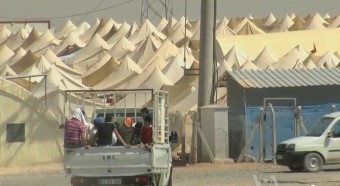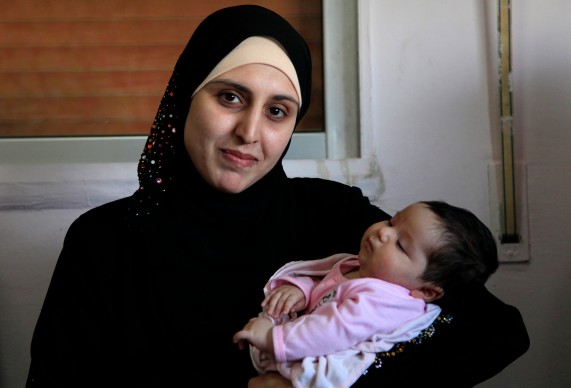
PTSD: For refugees, deep but invisible scars
When ordinary people are suddenly and inexplicably surrounded by war, life as they know it can cease to exist. They become the collateral damage. They are teachers, cab drivers, lawyers, bakers, mothers, fathers, children – all running away from devastation and toward the unknown.
By Chris Worthy
DFW Education Coordinator
The hundreds of thousands of Syrian and Iraqi refugees currently living in Jordan are refugees in orbit – they have no true home where they are and the timeline for returning to their war-torn homelands is unknown. Everything – medical care, education, psychosocial support – is needed. Non-governmental organizations, like Collateral Repair Project, are critical players in the battle for life and death. A new crisis may be looming as the UN’s World Food Program faces a funding shortfall that is resulting in the suspension of its voucher program that helps Syrian refugees buy food. Nobel Peace Prize Winner Malala Yousafzi is turning international focus to the needs in Jordan, as she focuses on providing facilities and support for education for Syrian children.
Refugees need everything and are unable to provide it for themselves due to circumstances beyond their control. Their present and their future are at stake.
Collateral Repair Project is one organization making a difference. CRP is a 2015 featured program that provides for the mind-body healing of refugees and develops leadership skills in the women of the CRP community.
Scarring the body and the mind
When ordinary people are suddenly and inexplicably surrounded by war, life as they know it can cease to exist. They become the collateral damage. They are teachers, cab drivers, lawyers, bakers, mothers, fathers, children – all running away from devastation and toward the unknown.
When survival means leaving everything behind, refugees often bring only the clothes on their backs and the physical and mental scars of what was left behind. Post-traumatic stress disorder, the psychological aftermath of trauma, can be devastating.
“PTSD is nothing new, even though the American Psychological Association came up with the diagnosis in 1980 in the DSM III,” Claudia María Vargas, Affiliated Professor of Public Administration and Senior Fellow, Center for Public Service at the Mark O. Hatfield School of Government at Portland State University, said.
The trauma may be triggered by something that happens directly to the individual or it may be something witnessed.
“It may be one event or multiple events,” Vargas said. “It is considered a serious response to trauma. The disorder may occur a month or years later.”
Vargas has spent years studying PTSD in refugees.

Vargas said men, women and children can suffer from PTSD, but in some conflicts, many of those fleeing violence are women and children.
“When men are killed (in the conflict), more women and children are refugees,” she said. “That’s why you see higher levels of women and children. I think that is happening in Syria.”
Numbers from the United Nations High Commissioner for Refugees are staggering: more than 600,000 persons of concern from Syria in Jordan alone, with more than $1 billion in funding requirements (and a $400 million gap in funds). But Vargas said those numbers reflect only a portion of the true refugee population. Many go unregistered with the UNHCR because they don’t know how to register or there are physical barriers, such as not having a local office, that prevent registration.
“They are probably 50 percent or less of the actual numbers,” she said.
The new rules of war
— Prof. Claudia Maria Vargas, Portland State University
The suffering experienced by refugees is often unimaginable. They have left jobs, homes, schools, structure and routine, loved ones and much more.
“Cultural bereavement, the loss of community culture and familial connections, usually occurs in tandem with PTSD,” Vargas said.
Refugees often suffer from malnutrition. “Women tend to be the last to eat,” Vargas said. “First, they feed the men and the children.”
Many female refugees are also coping with the aftermath of sexual assault. “Rape is now a weapon of war,” Vargas said. “The numbers are really high. It’s quite frightening how many are suffering from this. Sexual violence is across all age spans. Rape is also committed against boys and men – not just women.”
As they flee conflict zones, Vargas said some women continue to experience sexual assault in exchange for food or documents. “Women may not have support,” she said. “Many face stigmatization.”
Vargas pointed to Bosnian refugees as a group that often remained silent about rape out of fear of rejection by their families. In the Democratic Republic of the Congo, women who had been sexually assaulted during war were sometimes rejected by their husbands and kept away from their children, according to Vargas.
“If you can imagine being raped, going to your family and being rejected by your family,” she said. “It triggers a cascade of traumatic events. The education component is equally important (to recovery) so they can know that rape and sexual violence are condemned by the international community. They realize that what happened to them, they did not provoke. It was a war crime.”
Many refugees have suffered physical injuries as well, either inflicted through torture or suffered in the flight from the conflict.
“Clearly, those events trigger PTSD,” Vargas said. “The impact can be very debilitating.”
While anyone with PTSD may suffer from any of the common symptoms, women tend to experience more depression and anxiety disorders and men may be more aggressive or turn to alcohol abuse. Children may have physical complaints, such as headaches or stomach pain. They may regress to bedwetting, clinging to parents, have disrupted sleep patterns, nightmares and fears of the dark. Older children and adolescents may have nightmares, be inattentive or have depression.
“Adolescents tend to experience a ‘frozen in time’ – a lack of sense of the future,” Vargas said. “They can’t see a future.”
Anyone suffering from PTSD may experience flashbacks in which they relive their traumatic experiences.
Sadly, this new warfare isn’t bound by geography or cause.
“We keep hoping now the conflicts will end,” Vargas said. “It just continues. They are also becoming more focused on targeting civilians and women and children. The old rules of war are no longer applicable where it was warrior to warrior. Now, it is more brutal. The consequences will have lasting impact through generations.”
Finding the light
Once the physical needs of refugees have been addressed, there is much more to be done.
Psychosocial needs must be met in a way that is culturally appropriate, Vargas said. Somali women who fled to Canada participated in sewing circles where they could talk and support each other. Bosnian women were a part of walking teas where they simply walked together, drank tea and gained comfort from companionship. In Chile, victims of the Pinochet regime created tapestries together.
Community-centered programs, like those provided by Collateral Repair Project, can be a critical source of healing, according to Vargas.
Creating a space for a spiritual dimension to be a part of the healing process is important, Vargas said, as is the opportunity for ritual and tradition, such as sharing meals together. Art programs and poetry may help PTSD sufferers to process trauma. She noted CRP’s dominoes night for men as a community building event for men recovering from trauma. Seemingly small programs can reap big rewards.
“Any of those things that can be instituted in a center can be very helpful,” Vargas said. “Yoga – that’s really helpful to help them relax and also gain some mobility if they have endured a lot of pain or injuries.”
Giving leadership training to refugees can help them regain a sense of self.
“It’s really critical to ask what they prefer,” Vargas said. “Including them in that process will also empower them to take control. One of the things that happens in PTSD is that people lose control.”
Age-specific programs allow children to deal with PTSD in ways that are developmentally appropriate.
“Teen-agers are usually the most neglected group, and yet their symptoms of PTSD are very similar to adults,” Vargas said. “For children, drawing becomes really useful. They draw or paint or use play dough or puppets. It’s difficult for PTSD-affected persons to talk about their trauma. They may talk about it as if it happened to someone else.”
Creating community can be the start of a new future.
“Their society and their families are torn apart,” Vargas said. “Healing through a center that can provide a sense of order and predictability can be very helpful.

